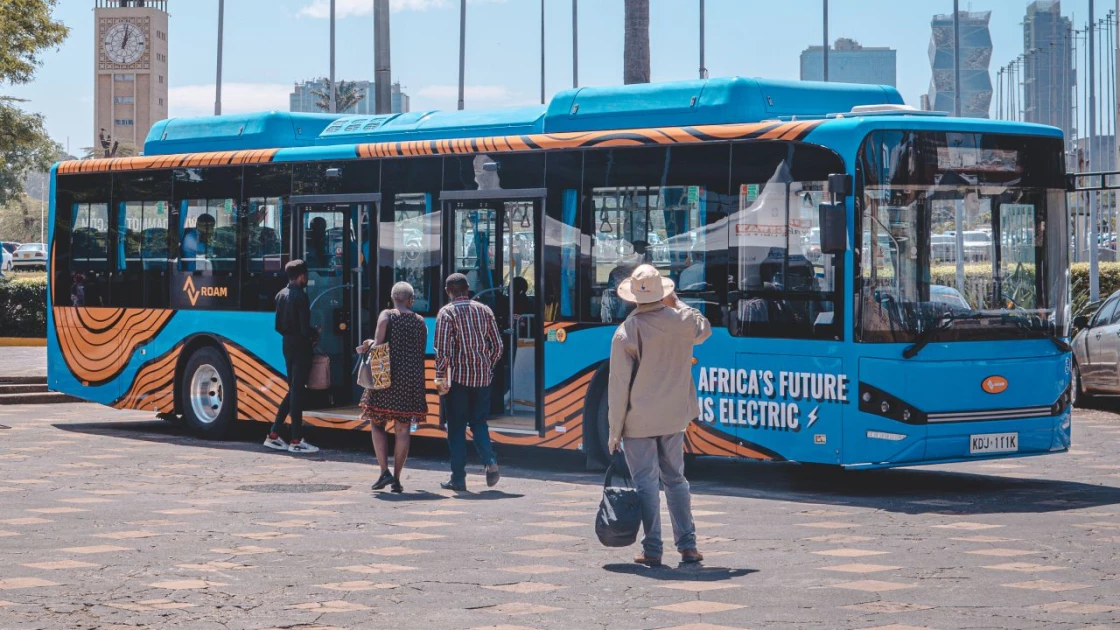Electric buses are driving a silent revolution in Nairobi

A Roam Rapid electric bus in Nairobi, Kenya. At least two mobility startups are looking to make inroads in the city's transport market with modern, sustainable alternatives to Nairobi's ubiquitous matatus (privately owned and operated minibuses).PHOTO|Courtesy|Roam

Audio By Vocalize
During the early days of the coronavirus pandemic in Nairobi, Kenya,
something improbable happened: a mountain appeared. To curb the
transmission of the virus, authorities called on the city’s thousands of
private bus operators to cease trading. “Within three days, the air completely
cleared,” recalls entrepreneur Jit Bhattacharya. “You could see Mount Kenya …
crystal clear,” some 90 miles away.
Bhattacharya also saw an opportunity. Kenya produces 90% of its
electricity from renewable sources – mostly geothermal and hydropower –
and has surplus grid capacity, yet it imports nearly all its petroleum
fuels. What if clean energy could be channelled into the transport sector? Maybe
it could help the city clean up its act. Maybe Mount Kenya could become a
permanent feature for Nairobi once more.
The Kenyan capital is home to over five million people, and matatus,
privately owned minibuses and shared taxis, “are critical to the way people in
Nairobi get around,” explains Christopher Kost, Africa program director at the
Institute for Transportation and Development Policy. “In the city, we have 40%
of trips on public transport.”
“The challenge that we’re facing now is that these matatus are stuck in
traffic,” he adds. “People face delays, the service is not always reliable.
Those are issues that we need to correct.”
Electric buses could help solve the problem. Today Bhattacharya is the
CEO and co-founder of BasiGo, a mobility startup racing to electrify the city’s
buses. The company is not alone. Swedish-Kenyan electric vehicle manufacturer
Roam also has its eyes set on Nairobi’s mass transport sector. Both are rolling
out fleets of buses this year that could mark the start of a new chapter for the city’s famous matatu culture.
Enabling a clean
energy transition
BasiGo started by importing two 25-seat buses from Chinese electric
vehicle giant BYD and began a pilot scheme in March 2022. Operating on a fixed
route in Dandora, a neighbourhood in east Nairobi, the CEO says the two buses
have carried 175,000 passengers and driven over 135,000 kilometres (84,000
miles) to date. “What’s most remarkable is that in that entire time, they’ve
had less than two days of technical downtime,” he adds.
In the coming weeks, 15 more buses will hit the streets. These vehicles
have been imported as kits, which are being constructed in the coastal city of
Mombasa, creating jobs and reducing taxes, Bhattacharya explains.
Rather than operate its fleet, BasiGo is selling buses directly to
Nairobi’s private operators through a “pay-as-you-drive” scheme. Bhattacharya
says that in doing so, buyers can purchase a BYD electric bus for a similar
upfront cost as a diesel bus of a similar size.
As part of the deal, drivers receive free bus servicing and maintenance,
and free charging. The charging infrastructure – which taps into the national
grid – is being deployed along busy routes at stations where buses typically
stop overnight. (The aim, says Bhattacharya, is to transition to electric “with
no behaviour change” on the part of drivers.)
BasiGo’s buses have a range of 250 kilometres (155 miles) and recharge in
four hours. Under the company’s model, BasiGo retains ownership of the bus’s
battery (“as much as 40-50% of the value of the vehicle”), which means after
eight years or 600,000 kilometres (373,000 miles), the battery is replaced and
the old battery either given a second life in a non-vehicular application or
recycled, says Bhattacharya.
The startup says it has received over 100 reservations so far. It aims to
have 100 buses on Nairobi’s roads by the end of the year and 1,000 buses
operating by the end of 2025.
Making electric a
competitive alternative
Meanwhile, Roam is making plans of its own. The electric mobility startup
formerly known as Opibus, an Earth shot Prize finalist in 2022, has two separate
bus models designed for Nairobi’s needs.
The Roam Rapid can seat up to 90 people, has a range of over 360
kilometres (224 miles) and is designed to carry passengers along major
corridors and on routes such as airport transfers.
The bus has undergone four pilot schemes and is currently being trialled
on Thika Road, a major highway in the capital. Roam says it aims to have up to
10 Rapid models in private use by the end of the year. It is waiting on the
results of a government tender linked to the city’s upcoming BRT (Bus Rapid
Transit) network, which could result in a contract for up to 100 buses.
“We feel
that we developed a product that is lovable and usable and bottom line
functional,” says project coordinator Dennis Wakaba – and with prices starting
at $245,000 (Ksh. 30.7 million), the Rapid is competitive with diesel equivalents of similar
quality, he argues.
The Roam Move is a smaller bus designed to compete with the traditional
matatu market. Wakaba claims the bus will cost 20 Kenyan shillings ($0.16) to
run per kilometre, compared to 50 to 60 shillings ($0.40 to $0.48) for a diesel
equivalent. Through a financing model – the details of which are yet to be
finalized – he says drivers could recoup the cost of the vehicle in four to
five years. The Move is still in the prototype stage, but Roam plans to have 10
units completed by October.
For now, charging is only available at Roam’s workshop in the city,
although Wakaba says permission to install publicly-accessible chargers on
Thika Road has been granted, and Roam plans to install charging points along
routes for top-up charging during the day and full recharging overnight.
Product and strategy chief Albin Wilson is keen to draw a distinction
between Roam and its competitor.
“The biggest difference is that we design our products (ourselves),” he
argues, tailoring battery size, bus size and other factors for the Kenyan
market. “We’re working really in a different vertical,” Wilson insists.
Kost believes that while healthy competition in the private sector will
ultimately benefit consumers, the public sector also needs to get involved. “It
won’t be sufficient to just change the vehicles to e-buses. We need to make
sure that there are improvements in infrastructure and operations and
regulations at the same time,” he says.
“The ideal arrangement is where the government is investing in the quarters,
in the stations and the depots, and then the private sector is able to bring
capital to invest in the buses,” he adds.
“Nairobi will be a much more efficient city if we have a decent public
transport system that offers reliable, fast service,” Kost concludes, with
potential economic benefits that could incentivize the government to get on
board.
BasiGo and Roam are already setting their sights beyond Nairobi and
Kenya. “We’re really excited to take this model for scalable electrification of
the public transport system to other markets,” says Bhattacharya, naming
Rwanda, Uganda, Tanzania and Ethiopia as potential countries for BasiGo’s
expansion. Roam says it is looking for tenders for the Roam Rapid across East
Africa and plans to roll out the Roam Move across the region in late 2024.
In the meantime, both companies are doing all they can to win over the
city’s drivers and commuters to their products. Electrification may not spell
the end of the matatu, after all. It could be an upgrade instead.
“We want to make these accessible to all people across the city of
Nairobi. Rich, poor, “it doesn’t matter,” says Bhattacharya. “I think
passengers, once they go and experience (our buses), they’re not ready to go
back.”


Leave a Comment